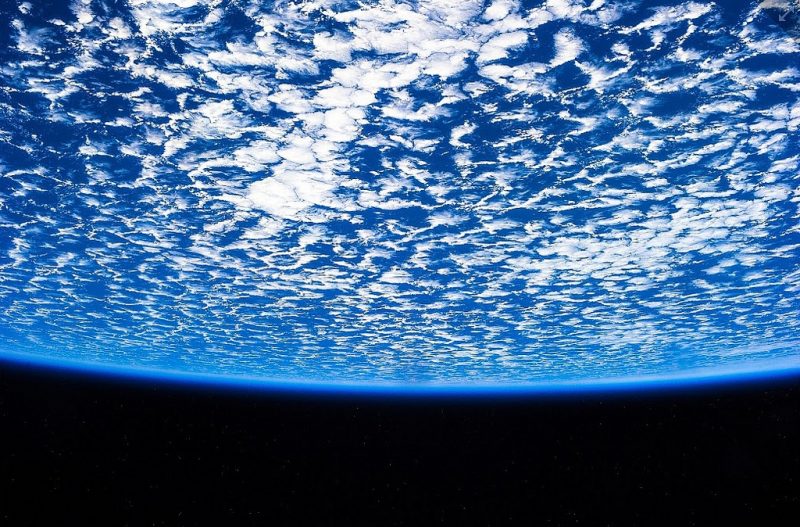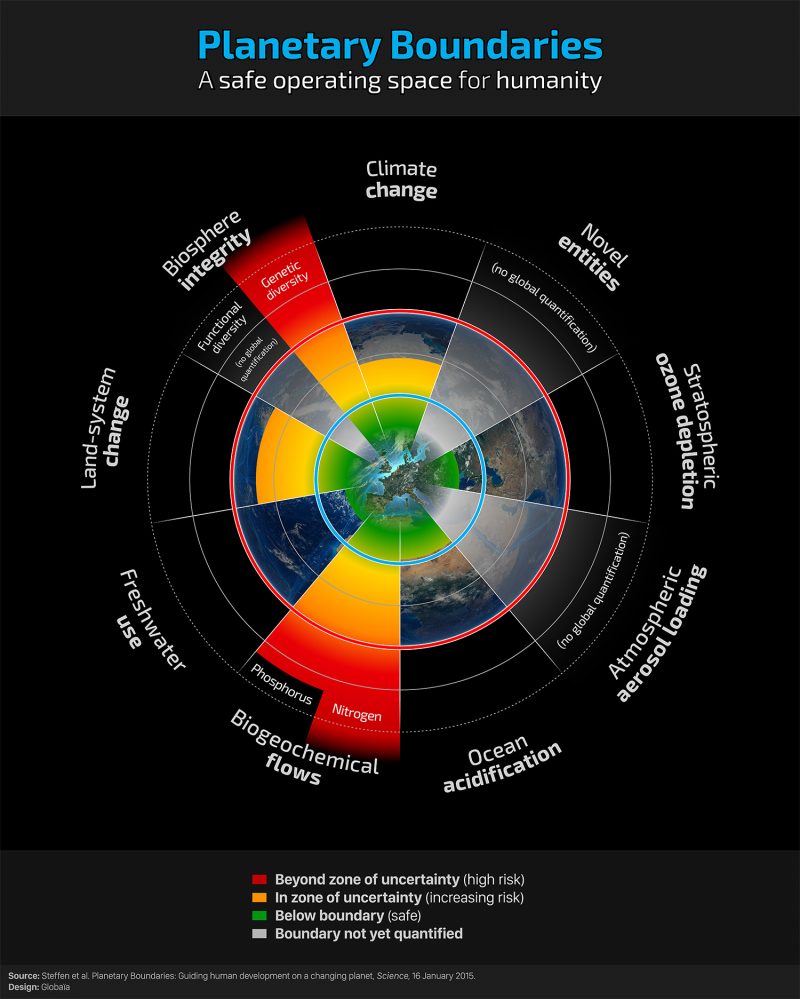What Planetary Boundaries 2.0 mean for green economy

The new Planetary Boundaries 2.0 framework improves and updates the influential analytical model - including stronger linkages with the green economy
A new version of the influential ‘planetary boundaries’ analysis was published in January. Many of the authors are the same as those who wrote the key Rockstrom et al articles in 2009. They have not changed the overall picture fundamentally, but they have taken into account a great deal of recent science and many of the criticisms which the original analysis provoked.
This line of thinking is important for the green economy debate, because ‘planetary boundaries’ are an attempt to identify and quantify just what the safe limits are to human impact on the planet – the vast majority of that impact being the result of economic activity. If we know where the boundaries are, we know what space we have to work within.
This analysis is in scientific terms – the biology and chemistry of the planet. It doesn’t propose a limit to total world GDP, because GDP consists of many different things, with very different ecological implications; and it doesn’t propose quantifying everything in money terms, which is very vulnerable to changes in the market, such as the fall in the price of oil. The approach is therefore different from both the ‘anti-growth’ and ‘capitals’ (‘natural capital, ‘human capital’, etc) perspectives, both of which fall into the trap of taking economic ideas rather than the physical world as the primary reality.
“ The overall picture of ‘planetary boundaries’ is that there are nine environmental boundaries it is dangerous to cross, and much less risky to stay within.”
Whilst being much less volatile than the market, science still changes. The new update is an attempt to incorporate new scientific findings and respond to some of the difficulties that were raised by the earlier version of the analysis.
Published in the journal ‘Science’, 15.1.15, with the title ‘Planetary Boundaries: Guiding development on a changing planet’, Will Steffen, et al., the update is different from the 2009 analysis it replaces in six different ways, which I will summarise here.
-
First, in some cases numbers have been revised in the light of recent evidence. The most important example is the reduction in the width of the zone of uncertainty for CO2 concentration in the atmosphere. It is now clear that between 450 and 550 ppm is unsafe, making the uncertainty zone now range from 350 to 450 annual average, instead of 350 to 550 (currently the figure is 396.5).
-
Second, there are various places where the concept of what the boundary is about has been changed, even though the same nine boundaries basically remain. “Rate of biodiversity loss” is now replaced by “change in biosphere integrity” (one imperfect measure of which is extinction rate). In place of “interference with the global Phosphorus and Nitrogen cycles”, there is a more wide-ranging “biogeochemical flows” boundary (although in fact measured by changes in Phosphorus and Nitrogen). “Chemical pollution” becomes the more wide-ranging “introduction of novel entities”, i.e. substances nature has not evolved to absorb. The other boundaries remain the same.
-
Third, there are some changes to what is measured in order to judge where the world is in relation to the boundary. The most important example here is that “land-system change” is now measured by change in area of forested land rather than cropland, because of the major impact of forests on climate. This change in indicator leads to the claim that the planet has now exceeded four boundaries, rather than only the three which were identified in 2009 (climate, biodiversity, nitrogen). In the case of the “novel entities” boundary, no specific quantified boundary has yet been identified.
-
Fourth, one of the criticisms made of the 2009 analysis was that in focusing on the global level, there was a failure to adequately consider what is happening on regional and other smaller scales. This is particularly important for freshwater use, where there is now an additional indicator specific to each particular river basin, as well as the global boundary. Some critics will see this as a retreat from the ‘planetary’ in ‘planetary boundaries’.
-
Fifth, there is also more emphasis in this new version on interdependence and interactions between the nine boundary factors, which create feedback effects of different kinds.
- And lastly, a further change is the identification of two of the nine as “core” boundaries, in what is described as a “two-level hierarchy”. These are climate change and biosphere integrity, which are highly interrelated with each other and with all the other boundaries. They constitute the core of what is problematic about the current earth system.
This is merely a brief summary. The paper itself not only has further detail but is backed up by 158 footnotes, almost all references to scientific papers. There is also available on the internet (through sciencemag.org) a whole set of ‘supplementary materials’. This is a pretty thorough job, taking us through from the big picture of the nine boundaries to a mass of detailed argumentation and evidence.
There is a significant limitation, however, on what the authors have achieved. As Johan Rockstrom and Katherine Richardson told the ‘New York Times’ journalist Andrew Revkin: the paper “is a natural science update ... It makes no attempt to enter the (very important) social science realm of equity, institutions or global governance.”

In that sense, ‘planetary boundaries’ analysis ends where the ‘green economy’ analysis needs to begin. It requires a sort of social science ‘twin’, analysing the forces that are currently driving human impacts beyond the boundaries. That would need to look, above all, at the economic system which humans (some more than others of course) have constructed. It would have to be a highly political undertaking, which most natural scientists understandably shy away from, but it is a job that needs to be done if we are to have any hope of remaining within what the authors call “the safe operating space for humanity”.
One of the biggest problems we face here is that there are no political or economic institutions corresponding at a global level to the planetary boundaries challenges. The IMF, World Bank, and WTO operate outside the UN system with an agenda deriving essentially from the need for economic reconstruction after World War Two (although there are efforts from within the World Bank to move beyond that). The UN Security Council considers military threats to security but not those caused by climate change or food or water shortages. These bodies need to be redesigned to fit the sustainability issues of the present. And the High-Level Political Forum established by the Rio+20 conference remains completely under-resourced, and currently in no position to take on these tasks.
Some critics of ‘planetary boundaries’ see it as necessarily leading to plans for top-down world government. This is not the case. Although there is a gap in governance at a global level on issues such as climate change, there is also a continuing need for action at national, regional, and local levels. This in turn implies that we should add equity into the planetary boundaries picture, partly in order to get some measure of the scale of change required in different parts of the world.
A green economy agenda focused on creating economic justice and maintaining the earth’s living systems is the natural positive counterpart of the ‘planetary boundaries’ analysis. The green economy is all about how we deal with the issues of equity, institutions, and governance within the context of “the safe operating space”. It raises many of the old long-standing issues about how human society should be organised – but now within an understanding that the space we have is limited. We need to know as precisely as possible what these limits are, and this new planetary boundaries update is an important contribution to finding that out.
Victor Anderson, Global Sustainability Institute
Image credit: "Earth" (CC BY-NC-ND 2.0) by Bernie Goldbach


